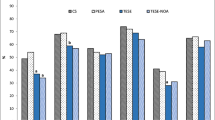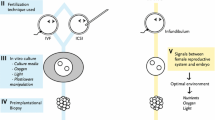Abstract
Purpose
To investigate whether in vitro fertilization (IVF) and intracytoplasmic sperm injection (ICSI), influence the embryo’s development and its quality using the mouse as a model.
Methods
Assisted fertilization was performed using ICSI and IVF. Fluorescent beads were adhered to the fertilization cone or place of previous sperm injection in the natural mated (NM), IVF and ICSI embryos, respectively. Embryo examination was carried out at the two-cell and blastocyst stage to determine the position of fluorescent bead. Protein expression was detected by fluorescence immunocytochemical staining and confocal microscopic imaging of blastocysts.
Results
IVF and ICSI embryos developed at rates comparable to NM group. Embryos show similar expression patterns of two transcription factors, Oct4 and Cdx2. The most preferred place for spermatozoa attachment was the equatorial site of the egg, whether fertilization occurred in vitro or under natural conditions. We also link the sperm entry position (SEP) to embryo morphology and the number of cells at the blastocyst stage, with no influence of the method of fertilization.
Conclusions
IVF and ICSI, do not compromise in vitro pre-implantation development. Additional data, related to sperm entry, could offer further criteria to predict embryos that will implant successfully. Based on embryo morphology, developmental rate and protein expression level of key transcription factors, our results support the view that ART techniques, such as IVF and ICSI, do not perturb embryonic development or quality.




Similar content being viewed by others
References
Amor DJ, Halliday J. A review of known imprinting syndromes and their association with assisted reproduction technologies. Hum Reprod. 2008;23(12):2826–34.
Andersen AN, Goossens V, Ferraretti AP, Bhattacharya S, Felberbaum R, de Mouzon J, et al. Assisted reproductive technology in Europe, 2004: results generated from European registers by ESHRE. Hum Reprod. 2008;23:756–71.
Avery S, Blayney M. Effect of the position of the meiotic spindle on the outcome of intracytoplasmic sperm injection. Hum Fertil (Camb). 2003;6:19–22.
Beck F, Erler T, Russell A, James R. Expression of Cdx-2 in the mouse embryo and placenta: possible role in patterning of the extra-embryonic membranes. Dev Dyn. 1995;204:219–27.
Black M, Liu DY, Bourne H, Baker HW. Comparison of outcomes of conventional intracytoplasmic sperm injection (ICSI) and ICSI using sperm bound to the zona pellucida of immature oocytes. Fertil Steril. 2010;93:672–4.
Brezinova J, Oborna I, Svobodova M, Fingerova H. Evaluation of day one embryo quality and IVF outcome – a comparison of two scoring systems. Reprod Biol Endocrinol. 2009;3:7–9.
Bridges PJ, Jeoung M, Kim H, Kim JH, Lee DR, Ko C, Baker DJ. Methodology matters: IVF versus ICSI and embryonic gene expression. Reprod Biomed. 2011. Online May 8:Epub ahead of print
Center for Disease Control and Prevention (2008) “ART National Report”, November
Chawengsaksophak K, James R, Hammond VE, Kontgen F, Beck F. Homeosis and intestinal tumours in Cdx-2 mutant mice. Nature. 1997;386:84–7.
Cruz M, Garrido N, Herrero J, Pérez-Cano I, Muñoz M, Meseguer M. Timing of cell division in human cleavage-stage embryos is linked with blastocyst formation and quality. Reprod Biomed Online. 2012;25(4):371–81.
Ebner T, Moser M, Sommergruber M, Tews G. Selection based on morphological assessment of oocytes and embryos at different stages of preimplantation development: a review. Hum Reprod Update. 2003;9(3):251–62.
Ecker DJ, Stein P, Xu Z, Williams CJ, Kopf GS, Bilker WB, et al. Long-term effects of culture of preimplantation mouse embryos on behavior. Proc Natl Acad Sci USA. 2004;101:1595–600.
Evans JP, Foster JA, McAvey BA, Gerton GL, Kopf GS, Schultz RM. Effects of perturbation of cell polarity on molecular markers of sperm-egg binding sites on mouse eggs. Biol Reprod. 2000;62:76–84.
Foresta C, Garolla A, Bartoloni L, Bettella A, Ferlin A. Genetic abnormalities among severely oligospermic men who are candidates for intracytoplasmic sperm injection. J Clin Endocrinol Metab. 2005;90:152–6.
Fortunato A, Tosti E. The impact of in vitro fertilization on health of the children: an update. Eur J Obstet Gynecol Reprod Biol. 2011;154(2):125–9.
Gardner DK, Schoolcraft WB. Towards reproductive certainty: infertility and genetics beyond. In: Jansen R, Mortimer D, editors. In vitro culture of human blastocysts. Carnforth: Parthenon Press; 1999. p. 378–88.
Giritharan G, Talbi S, Donjacour A, Di Sebastiano F, Dobson AT, Rinaudo PF. Effect of in vitro fertilization on gene expression and development of mouse preimplantation embryos. Reproduction. 2007;134(1):63–72.
Giritharan G, Li MW, De Sebastiano F, Esteban FJ, Horcajadas JA, Lloyd KC, et al. Effect of ICSI on gene expression and development of mouse preimplantation embryos. Hum Reprod. 2010;25(12):3012–24.
Gray D, Plusa B, Piotrowska K, Na J, Tom B, Glover DM, et al. First cleavage of the mouse embryo responds to egg geometry that reflects the position of sperm entry. Curr Biol. 2004;9:397–405.
Hvidtjørn D, Grove J, Schendel D, Vaeth M, Ernst E, Nielsen L, et al. ‘Vanishing embryo syndrome’ in IVF/ICSI. Hum Reprod. 2005;20:2550–1.
Jones Jr HW, Jones GS, Andrews MC, Acosta AA, Bundren C, Garcia J, et al. The program for in vitro fertilization at Norfolk. Fertil Steril. 1982;38:14–21.
Kimber SJ, Sneddon SF, Bloor DJ, El-Bareg AM, Hawkhead JA, Metcalfe AD, et al. Expression of genes involved in early cell fate decisions in human embryos and their regulation by growth factors. Reproduction. 2008;135:635–47.
Kimura Y, Yanagimachi R. Mouse oocytes injected with testicular spermatozoa or round spermatids can develop into normal offspring. Development. 1995;121(8):2397–405.
Klemetti R, Gissler M, Sevón T, Koivurova S, Ritvanen A, Hemminki E. Children born after assisted fertilization have an increased rate of major congenital anomalies. Fertil Steril. 2005;84:1300–7.
Kohda T, Ogonuki N, Inoue K, Furuse T, Kaneda H, Suzuki T, et al. Intracytoplasmic sperm injection induces transcriptome perturbation without any transgenerational effect. Biochem Biophys Res Commun. 2011;410(2):282–8.
Liu F, Qiu Y, Zou Y, Deng ZH, Liu DY. Use of zona pellucida-bound sperm for intracytoplasmic sperm injection produces higher embryo quality and implantation than conventional intracytoplasmic sperm injection. Fertil Steril. 2011;95(2):815–8.
Macas E, Imthurn B, Rosselli M, Keller PJ. The chromosomal complements of multipronuclear human zygotes resulting from intracytoplasmic sperm injection. Hum Reprod. 1996;11:2496–501.
Mann MR, Lee SS, Doherty AS, Verona RI, Nolen LD, Schultz RM, et al. Selective loss of imprinting in the placenta following preimplantation development in culture. Development. 2004;131(15):3727–35.
Martin-Du Pan RC, Sakkas D, Stalberg A, Bianchi PG, de Boccard G, Campana A. Treatment of male sterility using intra-oocytic sperm injection: critical evaluation. Schweiz Med Wochenschr. 1995;125:1483–8.
Nichols J, Zevnik B, Anastassiadis K, Niwa H, Klewe-Nebenius D, Chambers I, et al. Formation of pluripotent stem cells in the mammalian embryo depends on the POU transcription factor Oct-4. Cell. 1998;95:379–91.
Olson CK, Keppler-Noreuil KM, Romitti PA, Budelier WT, Ryan G, Sparks AE, et al. In vitro fertilization is associated with an increase in major birth defects. Fertil Steril. 2005;84:1308–15.
Ozil JP, Banrezes B, Tóth S, Pan H, Schultz RM. Ca2+ oscillatory pattern in fertilized mouse eggs affects gene expression and development to term. Dev Biol. 2006;300(534–544):51.
Paes Almeida Ferreira de Braga D, Iaconelli Jr A, Sávio C, de Figueira R, Madaschi C, Semião-Francisco L, et al. Outcome of ICSI using zona pellucida-bound spermatozoa and conventionally selected spermatozoa. Reprod Biomed Online. 2009;19:802–7.
Palermo G, Joris H, Devroey P, Van Steirteghem AC. Induction of acrosome reaction in human spermatozoa used for subzonal insemination. Hum Reprod. 1992;7:248–54.
Palmieri SL, Peter W, Hess H, Scholer HR. Oct-4 transcription factor is differently expressed in the mouse embryo during establishment of the first two extraembryonic cell lineages involved in implantation. Dev Biol. 1994;166:259–67.
Piotrowska K, Zernicka-Goetz M. Role for sperm in spatial patterning of the early mouse embryo. Nature. 2001;409:517–21.
Piotrowska K, Zernicka-Goetz M. Early patterning of the mouse embryo–contributions of sperm and egg. Development. 2002;129(24):5803–13.
Piotrowska-Nitsche K, Yang SH, Banta H, Chan AWS. Assisted fertilization and embryonic axis formation in higher primates. Reprod Biomed Online. 2009;18:382–90.
Plusa B, Piotrowska K, Zernicka-Goetz M. The first cleavage plane of the mouse zygote passes close by the sperm entry point defined by several labelling techniques. Genesis. 2002;32:193–8.
Qiao J, Chen Y, Yan LY, Yan J, Liu P, Sun QY. Changes in histone methylation during human oocyte maturation and IVF- or ICSI-derived embryo development. Fertil Steril. 2010;93(5):1628–36.
Rienzi L, Ubaldi F, Martinez F, Iacobelli M, Minasi MG, Ferrero S, et al. Relationship between meiotic spindle location with regard to the polar body position and oocyte developmental potential after ICSI. Hum Reprod. 2003;18:1289–93.
Rinaudo P, Schultz RM. Effects of embryo culture on global pattern of gene expression in preimplantation mouse embryos. Reproduction. 2004;128(3):301–11.
Rinaudo P, Giritharan G, Talbi S, Dobson AT, Schultz RM. Effects of oxygen tension on gene expression in preimplantation mouse embryos. Fertil Steril. 2006;86(4 Suppl):1252–65.
Ruiz de Assin R, Clavero A, Gonzalvo MC, Ramírez JP, Zamora S, Fernández A, et al. Comparison of methods to determine the assigned value in an external quality control programme for embryo evaluation. Reprod Biomed Online. 2009;19:824–9.
Santos F, Hyslop L, Stojkovic P, Leary C, Murdoch A, Reik W, et al. Evaluation of epigenetic marks in human embryos derived from IVF and ICSI. Hum Reprod. 2010;25(9):2387–95.
Scholer HR, Hatzopoulous AK, Balling R, Suzuki N, Gruss P. A family of octamer-specific proteins present during mouse embryogenesis: evidence for germ-line specific expression of an Oct factor. EMBO J. 1989;8:2543–50.
Scott L. The biological basis of non-invasive strategies for selection of human oocytes and embryos. Hum Reprod Update. 2003;9:237–49.
Silva CP, Kommineni K, Oldenbourg R, Keefe DL. The first polar body does not predict accurately the location of the metaphase II meiotic spindle in mammalian oocytes. Fertil Steril. 1999;71:719–21.
Steptoe P, Edwards RG. Birth after the reimplantation of a Human Embryo. The Lancet. 1978;312(8085):366.
Tesarik J, Rolet F, Brami C, Sedbon E, Thorel J, Tibi C, et al. Spermatid injection into human oocytes. II. Clinical application in the treatment of infertility due to non-obstructive azoospermia. Hum Reprod. 1996;11(4):780–3.
Turan N, Katari S, Gerson LF, Chalian R, Foster MW, Gaughan JP, et al. Inter- and intra-individual variation in allele-specific DNA methylation and gene expression in children conceived using assisted reproductive technology. PLoS Genet. 2010;6(7):e1001033.
Wong CC, Loewke KE, Bossert NL, Behr B, De Jonge CJ, Baer TM, et al. Non-invasive imaging of human embryos before embryonic genome activation predicts development to the blastocyst stage. Nat Biotechnol. 2010;28(10):1115–21.
Acknowledgments
The authors thank K. Larkin, S. Frankenberg, V. Horner and A. Long for comments on the manuscript. We also thank the veterinary staff and the animal resources at the Yerkes National Primate Research Center (YNPRC). All animal procedures were approved by the IACUC and the Biosafety Committee at Emory University. YNPRC is supported by the National Center for Research Resources P51RR165 and is currently supported by the Office of Research and Infrastructure Program (ORIP)/OD P51OD11132. This study is supported in part by Emory University Research Fund and grant awarded by the ORIP/NIH (RR018827) to AWSC.
Author information
Authors and Affiliations
Corresponding authors
Additional information
Capsule
IVF and ICSI, do not compromise in vitro pre-implantation development. Additional data, related to sperm entry, could offer further criteria to predict embryos that will implant successfully.
Electronic supplementary material
Below is the link to the electronic supplementary material.
ESM 1
(DOC 1061 kb)
Rights and permissions
About this article
Cite this article
Piotrowska-Nitsche, K., Chan, A.W.S. Effect of sperm entry on blastocyst development after in vitro fertilization and intracytoplasmic sperm injection — mouse model. J Assist Reprod Genet 30, 81–89 (2013). https://doi.org/10.1007/s10815-012-9896-6
Received:
Accepted:
Published:
Issue Date:
DOI: https://doi.org/10.1007/s10815-012-9896-6




